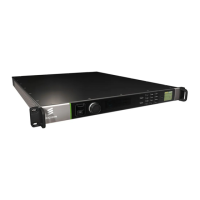6.1.5 UDP Layer
The UDP layer is according to RFC768 User Datagram Protocol. The user can
control the target UDP port number for the MPEG-2 stream. A configurable number
of 188 byte long MPEG-2 TS packets are mapped straight into an UDP frame with
no additional overhead. The MTU for Ethernet is usually 1500 bytes. This limits the
number of MPEG-2 TS packets per UDP frame to lie within 1 to 7. The following
illustration shows the mapping of MPEG-2 Transport Streams into UDP packets.
Figure 6.3 Mapping of MPEG-2 TS Packets
6.1.6 IP Layer
The IP layer is according to RFC791 Internet Protocol Specification. The user is
allowed access to the following IP header fields: IP source address, IP destination
address, Time-To-Live field, Type-Of-Service field. Performing static mapping
between class-D IP addresses and the corresponding Ethernet multicast MAC
addresses supports limited IP Multicasting (Type 1).
6.1.7 Ethernet Layer
The data link layer is Ethernet according to IEEE 802.3/802.3u (auto sensing
10/100 Mbps, Twisted Pair, RJ-45 connector).
6.1.8 IP Overhead
The IP overhead calculation when mapping MPEG-2 TS packets into IP frames is
shown in Table 6.1.

